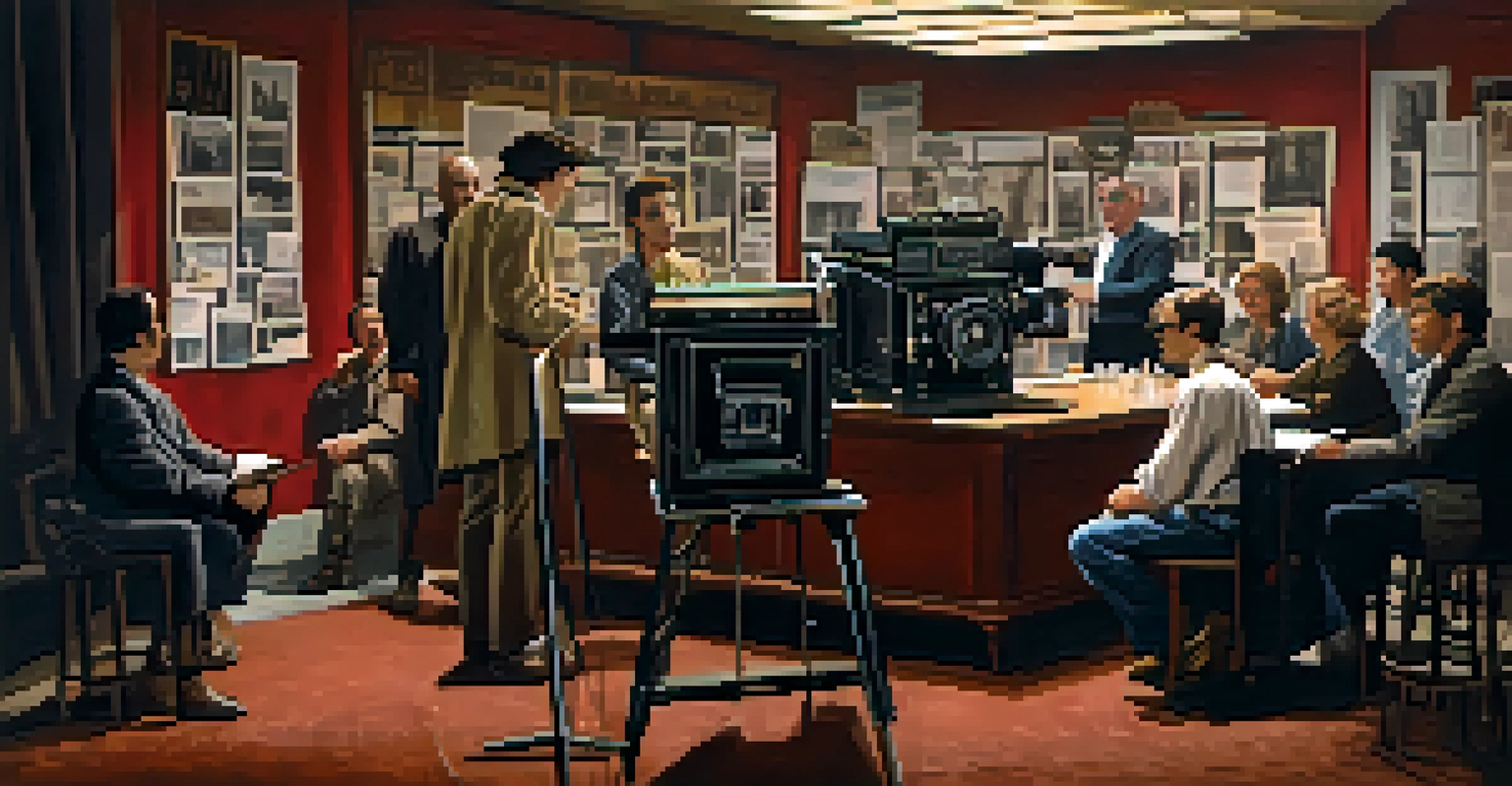From Page to Screen: The Art of Adapting Novels into Movies

Understanding the Appeal of Novel Adaptations
Adapting novels into movies has long captivated audiences and filmmakers alike. The rich narratives and complex characters found in literature provide a goldmine of material for screenwriters and directors. This appeal lies not just in the stories themselves, but also in the established fan base that novels often come with, ensuring a built-in audience for the film. It's a merging of worlds that invites both readers and non-readers to engage with the story, often sparking renewed interest in the original book.
Books are a uniquely portable magic.
Take, for example, the adaptation of J.K. Rowling's 'Harry Potter' series. The films brought the wizarding world to life, allowing fans to experience beloved characters and settings in a new way. Similarly, classics like 'Pride and Prejudice' continue to see various adaptations, showcasing the timelessness of the story. Such adaptations illustrate how stories can transcend their original format, reaching new heights and introducing them to different generations.
Ultimately, the appeal of these adaptations lies in their ability to visually interpret and expand the narratives we love, creating a shared experience that can be enjoyed by many. It’s about bringing the essence of a story to a wider audience while also inviting them to explore the source material.
The Challenges of Staying True to the Source Material
One of the biggest hurdles in adapting a novel into a film is the challenge of fidelity to the source material. Readers often have a strong attachment to the characters and plots they've grown to love, making any deviation feel like a betrayal. For instance, fans of 'The Hunger Games' series had mixed reactions to certain changes made in the film adaptations, demonstrating the delicate balance filmmakers must strike between loyalty and cinematic creativity.

Moreover, the constraints of time play a significant role in this challenge. A typical novel may span hundreds of pages, while a feature film usually runs for about two hours. This necessitates condensing complex plots and character arcs, often leading to the omission of beloved subplots or characters. This can frustrate fans who feel that the essence of the story has been lost in translation.
Adaptations Connect Readers and Fans
Adapting novels into films creates a shared experience that invites both book lovers and newcomers to engage with beloved stories.
Filmmakers must therefore make tough decisions about what to keep and what to cut, all while trying to maintain the heart of the story. It’s a balancing act that requires both respect for the original work and a creative vision that translates well onto the screen.
The Role of Screenwriters in Adaptation
Screenwriters are the architects of any film adaptation, tasked with transforming prose into a visual narrative. Their job involves distilling the essence of the novel and reimagining it for a different medium, which often requires a fresh perspective. For instance, in the adaptation of 'The Great Gatsby', the screenwriter had to encapsulate Fitzgerald's lush prose into a screenplay that could capture the era's glamour while still resonating with modern audiences.
The book is always better than the movie.
This process often involves making structural changes, such as altering timelines or character interactions, to better fit the pacing of a movie. Screenwriters might also enhance dialogue to create more dynamic exchanges that work well on screen. It's a creative challenge that can lead to innovative interpretations of beloved stories, as seen in the successful adaptation of 'Little Women', where the narrative was restructured to highlight themes of female empowerment.
In essence, screenwriters serve as the bridge between the written word and the visual world, translating inner thoughts and detailed descriptions into compelling visual storytelling. Their artistry is crucial in ensuring that the adaptation feels fresh while honoring the original narrative.
Casting: Bringing Characters to Life
Casting is a pivotal part of adapting novels into films, as the right actors can breathe life into characters that readers have envisioned in their minds. The selection process often involves considering both talent and the actor's ability to embody the character’s essence. Think of how Daniel Radcliffe became synonymous with Harry Potter; his portrayal was so authentic that it shaped fans' perceptions of the character for years.
However, casting decisions can also be contentious. When the beloved character of Katniss Everdeen was portrayed by Jennifer Lawrence in 'The Hunger Games', it sparked debates among fans about whether she matched their expectations. This illustrates the fine line filmmakers walk when choosing actors, as they must consider public opinion while also trusting their vision.
Balancing Fidelity and Creativity
Filmmakers face the challenge of staying true to the source material while making necessary cuts and changes to fit the film format.
Ultimately, successful casting can elevate an adaptation, creating memorable performances that resonate with audiences. When actors genuinely connect with their roles, they can transform a film into an emotional experience, leaving viewers wanting to revisit both the movie and the original book.
Directorial Vision: Shaping the Narrative
The director's vision plays a crucial role in how a novel is adapted into a film. They are responsible for translating the screenplay into a visual story, making choices about cinematography, pacing, and overall tone. For instance, Tim Burton's whimsical style brought a unique flair to 'Alice in Wonderland', transforming the classic tale into a visually stunning experience that felt both familiar and new.
Directors often interpret the source material through their own lens, which can lead to unique adaptations that deviate from the original story. This creative freedom can result in fresh takes on familiar tales. However, this can also alienate die-hard fans who expect a faithful representation of the novel, as seen with adaptations like 'The Shining', where Stanley Kubrick’s vision diverged significantly from Stephen King’s original narrative.
Ultimately, a director's ability to shape the narrative can either enhance or hinder the adaptation process. Their choices can bring out themes and emotions that resonate deeply with audiences, but they must tread carefully to honor the source material that inspired the film.
The Impact of Cinematography and Visual Storytelling
Cinematography adds another layer of depth to film adaptations, influencing how stories are perceived and felt by audiences. The use of lighting, camera angles, and shot composition can evoke emotions that enhance the narrative. For example, the dark, moody cinematography of 'The Road' perfectly mirrors the bleakness of Cormac McCarthy's novel, immersing viewers in its desolate world.
Visual storytelling allows filmmakers to convey themes and character emotions without relying solely on dialogue. This can be particularly effective in adaptations where inner thoughts and feelings are crucial, such as in 'The Perks of Being a Wallflower'. The film's visual representation of isolation and connection beautifully complements the book’s exploration of these themes.
Cinematography Enhances Storytelling
The art of cinematography plays a crucial role in conveying themes and emotions, enriching the audience's experience of the film adaptation.
In essence, cinematography serves as a powerful tool in adapting novels, enabling filmmakers to create an immersive experience that captures the heart of the story while engaging viewers on a sensory level. This artistry can ultimately dictate how audiences interpret and connect with the adaptation.
Audience Reception: The Verdict on Adaptations
Audience reception is a telling indicator of how successful a novel adaptation has been. It can vary widely, influenced by factors such as fidelity to the source material, casting choices, and even the director's vision. Some adaptations, like 'The Lord of the Rings', have garnered critical acclaim and box office success, while others, such as 'Eragon', faced backlash for not meeting expectations.
Social media has amplified this discourse, allowing fans to voice their opinions and share their experiences with adaptations. Hashtags and trending topics often emerge around new releases, creating a platform for discussion and debate. This communal aspect of viewing adaptations can foster a sense of collective nostalgia or disappointment, depending on the execution.

Ultimately, the success of an adaptation is measured not only by box office numbers but also by how well it resonates with both fans of the book and new audiences. A well-received film can breathe new life into the original novel, sparking interest and encouraging readers to explore the written word, while a poorly received adaptation may discourage engagement with the source material.